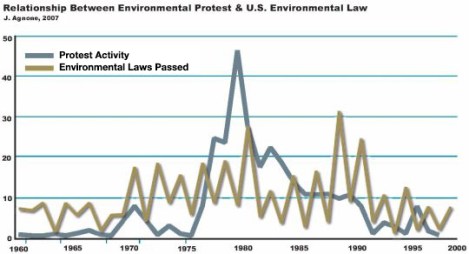The most important and relevant research for U.S. environmentalists is being conducted by Jon Agnone, a sociologist at the University of Washington. Agnone studies sources of environmentalist power — the first social scientist to undertake a systematic analysis. His comprehensive findings are summarized in “Amplifying Public Opinion: The Policy Impact of the U.S. Environmental Movement” (PDF), appearing in the June 2007 issue of Social Forces.
Agnone compared the relative impact of public opinion, institutional advocacy, and protest on passage of federal environmental legislation between 1960-1998, using a sophisticated analytical model and data drawn from The New York Times.
Three key findings in this first-ever quantification of environmentalist power upend conventional political wisdom:
- Protest is significantly more important than public opinion or institutional advocacy in influencing federal environmental law. Agnone found that each protest event increases the likelihood of pro-environmental legislation being passed by 1.2 percent, and moderate protest increases the annual rate of adoption by an astonishing 9.5 percent.
- Public opinion on its own influences federal action (though less than protest), but is vastly strengthened by protest, which “amplifies” public support and, in Agnone’s words, “raises the salience of public opinion for legislators.” Protest and public opinion are synergistic, with a joint impact on federal policy far more dramatic than either factor alone.
- Institutional advocacy has limited impact on federal environmental policy.
Agnone’s findings demonstrate that protest is neither a historical phase of the environmental movement nor a peripheral tactic: it is the central basis of environmentalists’ power. As Agnone notes, “these results lead to an important conclusion: when both protest and public opinion are at high levels, they jointly influence policy makers in ways that would be impossible if each existed without the other.”
When we stopped protesting, in other words, and began to rely on advocacy and mobilizing pubic opinion alone, we threw away our single most important lever of influence. The accompanying chart shows the correspondence between declining trend lines of environmental protest and passage of federal environmental law:

Every environmental lobbyist knows that our influence is greatest when there are people in the streets (or out in the Zodiacs). Agnone’s painstaking analysis is solid evidence that playing good cop/bad cop is more than good sense, it is our only effective path.
The implications for climate campaigning are significant. “Step It Up” type events and direct action by Greenpeace, Ruckus-trained activists, RAN, and other protest-oriented groups must be seen as our most important undertaking. Given this, a cost/benefit analysis of our present ratio of investment is sobering.
Applying Agnone’s findings, Step It Up — the work of a handful of Middlebury College students and Bill McKibben, operating with a modest $100,000 budget — will have single-handedly improved odds of federal action by 1.2 percent to 10 percent (if the effort sparks more protest). The sprawling public communications and advocacy operations of U.S. environmental organizations and foundations, on the other hand, at a cost of more than $150 million/year*, will not measurably influence U.S. policy.
The idea that one round of relatively small-scale rallies and events might exert such outsized influence, and that an enterprise in which we have invested tremendous resources, creative energy, and prestige over two decades is effectively worthless, is not easy to accept. The macropolitical mechanisms by which protest builds our power are intangible, while the day-to-day field work and advocacy which occupy the time and attention of most U.S. environmentalists feels like it is effective.
The quantum difference between wholesale, protest-driven political power and our present retail effort is most apparent to those of us whose experience reaches back to 1981-83. Protest adds unique ingredients to the civic equation. It demonstrates depth of commitment, putting a sharp point on wide but thin public support. Protest disrupts or threatens to disrupt, substantially upping the political ante and commanding attention in ways that polite institutional advocacy cannot approach.
It is a mistake to view advocacy and protest as a dichotomy between rational and emotional communications, as they are often perceived — and herein lays the key to understanding the power of protest.
For environmentalists and the small but growing percentage of Americans who have come to accept that the world as we know it is crashing down around us and who know that nothing serious is being done about it, the most rational response is to take to the streets. To continue our present strategy of downplaying climate change risk and making joint alliance with the chief architects of the massive ramp-up in global fossil fuel use is irrational.
Failure to protest robs us of our most important source of power and completely undercuts our story. The absence of significant protest against U.S. climate policy and continuing engagement in polite civic discourse tells Americans eloquently and emphatically that we don’t really believe what we are saying.
—–
Jon Agnone may be reached at:
University of Washington, Department of Sociology
202 Savery Hall, Box 353340
Seattle, WA 98195-3340
agnone@u.washington.edu
www.staff.washington.edu/agnone
—–
* 2005 estimate of combined U.S. environmental organization and foundation climate programs from unpublished report of a major U.S. environmental foundation.
[CORRECTION: The graph above originally mislabeled the two lines. It has now been corrected.]



